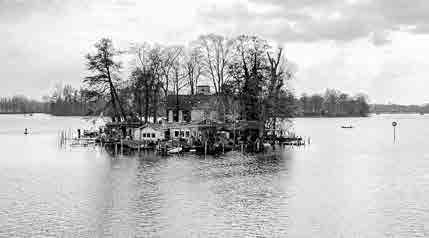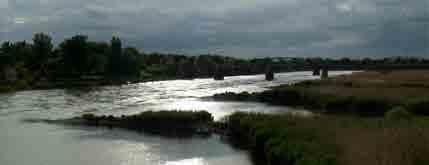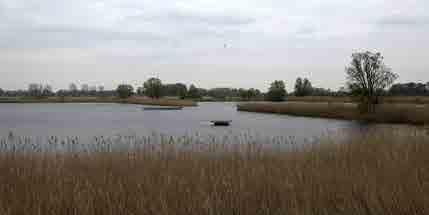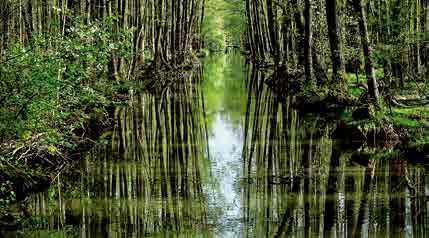
14 minute read
Bernhard Sallmann FONTANE ZYKLUS
Bernhard Sallmann FONTANE ZYKLUS
In seinem vierteiligen Zyklus folgt der gebürtige Österreicher und Wahl-Berliner Bernhard Sallmann seit 2016 den zwischen 1862 und 1889 erschienenen „Wanderungen durch die Mark Brandenburg“ von Theodor Fontane. Sallmann, dem das FilmFestival Cottbus 2018 eine Hommage unter dem Titel „Ein Wanderer in der Lausitz“ widmete, erschließt sich die Räume in der langsamen Bewegung, dem Er-Gehen von Räumen: „Es müssen die Dinge wirklich durch meine Füße gehen und durch den Körper.“ Seine künstlerische Methode ist das „obsessive Sezieren von Orten“, sein Markenzeichen die exakt kadrierte, statische und lange Einstellung im Verbund mit einer Tonspur, die eine eigene Dramaturgie entwickelt. „In den gemäldehaften und lang verweilenden Tableaus entsteht ein Resonanzraum, der Zeiten, Orte und verblüffende Geschichten amalgamiert“, so Sallmann. Dieser Blick fürs Detail und die Spuren der Geschichte im Gegenwärtigen finden in den – von Judica Albrecht virtuos gesprochenen – Fontane-Texten ihre Entsprechung: Beschreibungen von Landschaften und Orten sowie vom Alltag der Einwohner aller Schichten, ein sozial genauer Blick, stets angereichert mit Sagen und Legenden sowie historischen und philosophischen Exkursen. „Erstaunlicherweise ergibt sich aus der Linienführung der Elemente ‚Text‘ und ‚Ort‘ ein vielfältiges Gespräch des 19. Jahrhunderts mit unserer Gegenwart“, meint der Regisseur. ODERLAND. FONTANE beschäftigt sich neben dem Oderbruch, dem Barnim und der Märkischen Schweiz vor allem mit den Anstrengungen, eine Flusslandschaft trockenzulegen und nutzbar zu machen. In RHINLAND. FONTANE setzt Sallmann anhand ausgewählter Textpassagen aus Fontanes „Grafschaft Ruppin“ die Arbeitsverhältnisse von Torfstechern im 19. Jahrhundert, den preußischen Militarismus und kapitalistisches Spekulantentum ins Verhältnis zu einer heutigen, von Menschen bearbeiteten Sumpflandschaft. Mit SPREELAND. FONTANE (FFC 2018) begibt sich der Regisseur in die „eigentliche Wendei“, die Region zwischen Spreewald und Köpenick – wiederum eine vom Menschen geprägte Landschaft – bis hin zu den vielfältigen Folgen des Tagebaus. Noch tiefer in die Geschichte der Wenden und ihren Einfluss auf das gegenwärtige, vermeintlich homogene deutsche Brandenburg begibt sich HAVELLAND. FONTANE. Dieser vierte Teil visualisiert zudem die Verschmelzung der Flusslandschaft mit dem Großraum Berlin-Potsdam und schildert die Austauschverhältnisse der Mark mit der wachsenden Großstadt. Die Werke von Sallmann, die einzigartig in der deutschen und internationalen Filmlandschaft sind, gehören von Anfang an zum festen Bestandteil der Sektion Heimat/Domownja/Domizna und haben sich über die Jahre in Cottbus ein treues Publikum erspielt. Folgerichtig wird hier erstmals der gesamte Fontane-Zyklus an einem Tag, dem Festival-Sonntag, und anlässlich des 200. Geburtstags des in Neuruppin geborenen Schriftstellers aufgeführt. Eine kontemplative Reise vor die eigene Haustür. GL
Advertisement
Bernhard Sallmann FONTANE CYCLE
In this four-part cycle Austrian-born and Berlinerby-choice Bernhard Sallmann has, as of 2016, been retracing Theodor Fontane‘s “Ramblings through Brandenburg”, which were originally published in the period between 1862 and 1889. Sallmann, himself the subject of a homage from the FFC 2018 entitled “A Wanderer in Lusatia”, captures the essence of these spaces in slow movement, taking the time to feel them himself: “I have to really feel things under my feet and let them run through my body.” His artistic method is the “obsessive dissection of space”, his trademark the precisely framed, static long take in combination with a soundtrack that develops a dramatic effect of its own. In the words of Sallmann “the picture-perfect and slowly lingering tableaux evolve into a resonating chamber which amalgamates time and space with remarkable narratives.” This eye for detail and the traces of history in the present finds its counterpart in Fontane‘s texts, spoken with virtuosity by Judica Albrecht: descriptions of landscapes and places, as well as the everyday lives of townsfolk from various walks of life, a socially precise perspective that is repeatedly enriched by legends and myths, as well as historical and philosophical detours. “Remarkably the layout of the elements that make up ‚text‘ and ‚space‘ produce a multifaceted exchange between the 19th century and the present day” states Sallmann. ODERLAND. FONTANE takes a look not only at Oderbruch, Barnim and the Märkische Schweiz but also at attempts to drain a river landscape and thus make it fit for use. In RHINLAND. FONTANE Sallmann takes selected text passages from Fontane‘s “Die Grafschaft Ruppin” (Ruppin County) as the basis for a juxtaposition of the working conditions of nineteenth-century peat diggers, Prussian militarism and capitalist speculation with today‘s swamp-like landscape, heavily shaped as it is by human intervention. In SPREELAND. FONTANE (FFC 2018) the director sets off to what he terms the “real Wendish territories”, the region between the Spreewald and Köpenick, another landscape heavily shaped by human interference, inclusive of the far-reaching effects of open cut mining. HAVELLAND. FONTANE delves deeper into the history of the Wends and their influence on modern-day Brandenburg, otherwise widely believed to be an area that is homogeneously German. The latter, the cycle‘s fourth and final part, visualises the fusion of this river landscape with the greater area of Berlin-Potsdam and portrays the interactions that occur between the Mark and the ever-growing capital. Sallmann‘s work, unique both domestically and internationally speaking and a key element of the Heimat/ Domownja/Domizna programme section, have gained a loyal gathering in Cottbus over the years. Thus, it only seems fair that the complete Fontane cycle should feature on one day, the festival Sunday, in a year that furthermore marks the 200th anniversary since the birth of the Neuruppin-born author Fontane. A contemplative journey across the region the FFC calls home. GL Die vier Filme werden vom DOK Leipzig – Internationales Leipziger Festival für Dokumentar- und Animationsfilm – präsentiert. The four films are presented by DOK Leipzig – International Festival for Documentary and Animated Film.
Die Besiedlung der Mark Brandenburg durch die Wenden, der „Kampf gegen das übermächtige Deutschtum“, Christianisierung, wendische Bräuche und Alltag, schließlich die beginnende Assimilierung. Sallmann folgt Fontane durch eine Landschaft, in die sich die Geschichte eingeschrieben hat. Betörende Bilder, die die Spuren brachialer Gewalt doch in sich tragen. The colonisation of the Mark of Brandenburg by the Wends, the “struggle against the overpowering German culture”, Christianisation, Wendish traditions and everyday life, finally the commencing assimilation. Sallmann follows Fontane through a landscape that bears the marks of history. Enchanting images that nonetheless contain the traces of brute force.
Bernhard Sallmann Filme DIE FREIHEIT DER BÄUME (2003, short, doc, FFC 2018) DIE LAUSITZ 20 X 90 (2004, short, doc, FFC 2018) TRÄUME DER LAUSITZ (2009, FFC 2018) Heimat/Domownja/Domizna
Den historischen Bogen, den Theodor Fontane im dritten Teil seiner „Wanderungen durch die Mark Brandenburg“ schlägt, transformiert Bernhard Sallmann in visuelle Poesie: Abendhimmel und Morgendämmerung, weite Felder und Wiesenraine, Wolkengebilde, Bäume in allen Formen, Vögel und immer wieder das Wasser, das Licht und die Jahreszeiten. Durch die Landschaft ging der Mensch und hinterließ Wege, Brücken, Schleusen, Kirchen und Klöster, Schornsteine und Ruinen der Industriegesellschaft. Letztere grüßt immer wieder auch auf der Tonspur, wenn etwa Flugzeuglärm die Stille zerreißt. Das Idyll ist brüchig oder, wie Fontane sagt, seine Kehrseite umso dunkler. Mit Fontane und Sallmann finden zwei Meister mit scharfem Blick fürs Detail auf das Schönste zueinander. GL
Bernhard Sallmann transforms the historical line that Theodor Fontane draws in the third volume of his “Wanderungen durch die Mark Brandenburg” (“Ramblings through Brandenburg”) into visual poetry: sunset sky and dawn, vast fields and meadows, cloud formations, trees in all their variety, birds and over and over again water, light and the seasons. Humans travelled this landscape and left behind paths, bridges, water locks, churches and monasteries, chimneys and ruins left behind by the industrial age. The latter also repeatedly features in the soundtrack, for example, when the noise of an aeroplane cuts through the calm. The idyll is fragile, or, in Fontane’s words, its other side is all the darker. In Fontane and Sallmann, two masters with a keen eye for detail have perfectly found common ground. GL
Filmformat / Format Blu-Ray | doc. | Farbe / Colour Drehbuch / Script Bernhard Sallmann Kamera / Photography Bernhard Sallmann Ton / Sound Bernhard Sallmann Schnitt / Editing Christoph Krüger Produktion / Production Bernhard Sallmann Kontakt / Contact Bernhard Sallmann Schöneweiderstr. 19 12055 Berlin 030.6857675 bernhard.sallmann@berlin.de
Bernhard Sallmanns Filme sind Solitäre. Sie entziehen sich allen Konventionen, Formaten und Einübungen. Man muss sich einlassen. Vom ersten Bild an ist klar: Hier findet ein Kino statt, das andere Tugenden entfaltet als Narration und Entertainment. Das Vergnügen liegt in der Konzentration und Kontemplation. Die zu Stillleben kondensierten Bilder sind streng kadriert und so komponiert, dass sich erst bei längerer Betrachtung eine zarte Bewegung erschließt, mal eine Wolke, mal das Zittern der Blätter. Nach seiner Lausitz-Trilogie hat es den in Berlin lebenden Österreicher einmal mehr nach Brandenburg gezogen: ins Oderbruch, in eine Natur von paradiesischer Schönheit, die trügt. Es ist eine im 18. Jahrhundert von Menschen geschaffene Kulturlandschaft. Bernhard Sallman’s films are solitaires. They elude all conventions, formats and practices. You must open yourself to them. It’s clear from the first image: this is a kind of cinema that has other virtues than narrative and entertainment. The enjoyment comes from concentration and contemplation. The images, arranged as still lives, are rigorously framed and composed so that subtle movements become visible only after long contemplation – sometimes a cloud, sometimes the trembling of leaves. After his Lusatian trilogy the Berlin-based Austrian was drawn to Brandenburg once again: to the Oderbruch, an edenic but treacherous landscape. It’s a cultivated landscape, created by man in the 18th century.
Bernhard Sallmann Filme DIE FREIHEIT DER BÄUME (2003, short, doc, FFC 2018) DIE LAUSITZ 20 X 90 (2004, short, doc, FFC 2018) TRÄUME DER LAUSITZ (2009, FFC 2018) Heimat/Domownja/Domizna
In Theodor Fontane fand Sallmann einen Gleichgesinnten. Nur die Werkzeuge sind verschieden. Was er mit der Kamera einfängt, hat der Wanderer und Schriftsteller im vorletzten Jahrhundert mit dem Federkiel aufgezeichnet. Er berichtet von der Trockenlegung, der Ansiedlung der Kolonisten und Albrecht Daniel Thaers Theorie der Fruchtfolge. Wer glaubt, all das läge weit weg, irrt. Übersetzt ins Heutige sind das die globalen Themen der Agrarpolitik: Abwanderung und Monokultur. In der hohen Sprecherkunst Judica Albrechts finden Text und Bild ihre ziselierte Verschmelzung. Sallmanns Film enthält viele Botschaften, auch die: Lest Fontane und lernt sehen! Cornelia Klauß, Quelle: Katalog DOK Leipzig

Sallmann found a fellow spirit in the novelist Theodor Fontane. Only their tools are different. What he captures with the camera was recorded with a quill by the hiker and writer in the penultimate century. He wrote about draining the country, settling colonists there, and Albrecht Daniel Thaer’s theory of crop rotation. Anyone who believes that all this is far away is wrong. Translated to today these are the global issues of agrarian policy: emigration and monocropping. Judica Albrecht’s artful narration merges text and images in finely chiselled fashion. Sallman’s film has many messages and one of them is: read Fontane and learn to see! Cornelia Klauß, source: Catalogue DOK Leipzig
Filmformat / Format DCP | doc. | Farbe / Colour Drehbuch / Script Bernhard Sallmann Kamera / Photography Bernhard Sallmann Ton / Sound Klaus Barm Schnitt / Editing Christoph Krüger Produzent / Producer Bernhard Sallmann Produktion / Production Bernhard Sallmann Kontakt / Contact Bernhard Sallmann Schöneweiderstr. 19 12055 Berlin 030.6857675 bernhard.sallmann@berlin.de
Bernhard Sallmann arbeitet an einem mehrteiligen Filmprojekt, das sich der Auseinandersetzung mit Theodor Fontane und dessen „Wanderungen durch die Mark Brandenburg“ verschrieben hat. Nach ODERLAND. FONTANE ist RHINLAND. FONTANE der zweite Teil. Das Interesse des Filmemachers ist einerseits ein historisches, das sich in der genauen Rezitation von Passagen aus Fontanes Buch „Die Grafschaft Ruppin“ abzeichnet: Arbeitsverhältnisse von Torfstechern, preußischer Militarismus, kapitalistisches Spekulantentum, Selbstreflexionen des Autors oder die einschneidende Erfahrung des Dreißigjährigen Krieges. Andererseits ist Sallmanns Konzept einer strengen Orts- und Landschaftsregistratur in langen statischen Einstellungen mit Originalton der Gegenwart verpflichtet: Fernverkehrsstraßen durchziehen eine vom Menschen bearbeitete Sumpflandschaft, verschwiegene Seen tun sich im Buchenwald auf. Bernhard Sallmann is working on a film project in several parts dedicated to Theodor Fontane and his “Ramblings through Brandenburg”. RHINLAND. FONTANE is the second part and follows ODERLAND. FONTANE. The filmmaker’s interest is historic on the one hand, which emerges in the precise recital of passages from Fontane’s book “Die Grafschaft Ruppin” (Ruppin County): peat cutters’ working conditions, Prussian militarism, capitalist speculators, the author’s self-reflections or the drastic experience of the Thirty Years’ War. On the other hand, Sallman’s concept of a strict registry of places and landscapes in long, static shots with location sound is indebted only to the present day: long distance roads crisscross a marshy landscape; secluded lakes open up in the beech forest.
Bernhard Sallmann Filme DIE FREIHEIT DER BÄUME (2003, short, doc, FFC 2018) DIE LAUSITZ 20 X 90 (2004, short, doc, FFC 2018) TRÄUME DER LAUSITZ (2009, FFC 2018) Heimat/Domownja/Domizna
Ein anderer großer Wanderer, Georg Forster, reflektierte einmal seinen Enthusiasmus für die Beobachtung landschaftlicher Gegenwart und ihrer dahinterliegenden Geschichte mit den Worten: „Mehr hat man doch nicht, als was einem durch diese zwei Oeffnungen der Pupille fällt und die Schwingungen des Gehirns erregt. Anders als so nehmen wir die Welt und ihr Wesen nicht auf.“ Die Welt und ihr Wesen aufzuspüren, das ist auch Sallmanns Absicht. Ralph Eue, Quelle: Katalog DOK Leipzig

Another great rambler, Georg Forster, once reflected on his enthusiasm for the observation of the presence and underlying history of landscapes: “In the end one doesn’t have more than what falls through these two openings of the pupils to stimulate the vibrations of the brain. We have no other way of experiencing the world and its nature.” Experiencing the world and its nature is Sallmann’s intention, too. Ralph Eue, source: Catalogue DOK Leipzig
Filmformat / Format DCP | doc. | Farbe / Colour Drehbuch / Script Bernhard Sallmann Kamera / Photography Bernhard Sallmann Ton / Sound Klaus Barm Schnitt / Editing Christoph Krüger Produzent / Producer Bernhard Sallmann Produktion / Production Bernhard Sallmann Kontakt / Contact Bernhard Sallmann Schöneweiderstr. 19 12055 Berlin 030.6857675 bernhard.sallmann@berlin.de
Eine Reise durch die Region zwischen Spreewald und Köpenick auf den Spuren von Fontanes „Wanderungen durch die Mark Brandenburg“. Der Dichter beschrieb eine Landschaft, die es so kaum noch gibt und deren unbewegte Bilder Bernhard Sallmann in Kontrast zu den von Judica Albrecht suggestiv gelesenen Textzitaten setzt. Filmische Raumerkundung mit Sogwirkung. A journey through the region between Spreewald and Köpenick in the footsteps of Fontane‘s „Wanderungen durch die Mark Brandenburg“ (“Ramblings through Brandenburg”). The poet describes a landscape that hardly exists anymore and of which Bernhard Sallmann contrasts still images with the text quotations suggestively read by Judica Albrecht. A film exploration of space with a touching effect.
Bernhard Sallmann Filme DIE FREIHEIT DER BÄUME (2003, short, doc, FFC 2018) DIE LAUSITZ 20 X 90 (2004, short, doc, FFC 2018) TRÄUME DER LAUSITZ (2009, FFC 2018) Heimat/Domownja/Domizna
„Aber der Zeuthener See ist doch schon Vorterrain; die Villen hören auf, der Einfluss der Hauptstadt schwindet und die eigentliche »Wendei« beginnt“, schreibt Theodor Fontane im 1882 erschienenen Band „Spreeland“. Mit Blick fürs Detail erkundet er nicht nur die Natur, sondern interessiert sich für das Leben der Bewohner der Region, besonders der Wenden. Im dritten Teil seines Fontane-Zyklus‘ findet Sallmann eine von Industrialisierung und Kulturverlust geprägte Landschaft vor, deren spröde Schönheit seine Kamera festhält. Wiesen im Morgennebel, Baumgestalten, alte Kirchen und Schlösser, vor allem aber das Wasser in Seen, Teichen, Restlöchern, Fließen und Flüssen wird dabei zum Protagonisten. Der Text folgt der fontaneschen Route, während das Bild im Raum mäandert, immer wieder zu den Bergbaufolgen zurückkehrt und der Ton Eigenes hinzufügt. Nie illustriert das Bild den Text, sondern gerade aus ihrer Disparität entsteht ein spannungsgeladener Dialog von Vergangenheit und Gegenwart einer verletzlichen Landschaft. GL

„But Lake Zeuthen is already the countryside; the villas stop, the influence of the capital disappears and the actual „Wendei“ begins,“ writes Theodor Fontane in the 1882 published volume „Spreeland“. With an eye for the detail, he not only explores nature, but is also interested in the life of the inhabitants of the region, especially the Wends. In the third part of his Fontane cycle, Sallmann finds a landscape marked by industrialisation and cultural loss, whose brittle beauty his camera captures. Meadows in the morning fog, tree figures, old churches and castles, but above all water becomes the protagonist; in lakes, ponds, residual holes, rivers and streams. The text follows the route of Fontane, while the image meanders in space, returning again and again to the consequences of mining and the sound adding its own element. The image never illustrates the text, but rather precisely from its disparity arises a tension-laden dialogue between the past and present of a vulnerable landscape. GL
Filmformat / Format DCP | doc. | Farbe / Colour Drehbuch / Script Bernhard Sallmann Kamera / Photography Bernhard Sallmann Ton / Sound Klaus Barm Schnitt / Editing Christoph Krüger Produzent / Producer Bernhard Sallmann, Klaus Barm Produktion / Production Bernhard Sallmann Schöneweiderstr. 19 12055 Berlin 0175.6212657 030.6857675 bernhard.sallmann@berlin.de Kontakt / Contact Bernhard Sallmann Schöneweiderstr. 19 12055 Berlin 030.6857675 bernhard.sallmann@berlin.de








